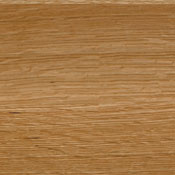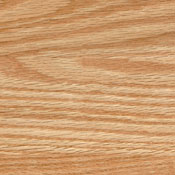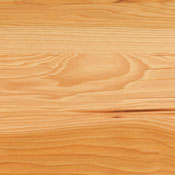Black Cherry - Prunus Serotina |
|
American Elm - Ulmus Americana The American Elm Tree used to be very common until the early 1930's. Around that time they were attacked by a deadly fungus that became known as the Dutch Elm Disease. It was accidentally introduced into America by the elm bark beetle which proceded to infect and destroy millions of elm trees. In recent years new varieties have been introduced that have higher resistance to the disease. The wood of the American Elm tree has a very interesting grain pattern revealing its intertwining fibers. The American Elm tree is known for its attractive umbrella shape and can grow up to 115' high. |
|
White Oak - Quercus Alba The White Oak is not as common as the Northern Red Oak tree. It has a light gray bark and the wood is whiter in color than the Red Oak tree. The White Oak tree is one of the largest trees in the Northeastern United States. It can grow to a height of up to 100' high. It is an excellent wood for flooring and for furniture because of its durability. When cut using the quartersawn method, the wood has a very pronounced ray flake or tiger stripe that gives it a very desirable grain pattern. Quartersawn white oak was the wood of choice for many of the Arts and Crafts craftsman during the latter part of the 1800's and the early part of the 1900's. It is a very hard, durable wood that rates 1360 on the Janka Hardness Scale |
|
Northern Red Oak - Quercus Rubra The Red Oak tree is probably the most commonly found hardwood tree in the Northeastern United States. It is known for its distinctive open grain pattern and durability as well as being the most inexpensive of the hardwoods because of its high availability. It is relatively easy to finish and has a consistent grain pattern. |
|
Hard Maple -Acer Saccharum Hard Maple is also known as Hard Rock Maple and Sugar Maple. It comes primarily from Northeastern United States and Southeastern Canada. Hard Maple lumber is known for its whitish/tan color that can also have a slight tinge of yellow. It finishes with a very smooth texture and is also very durable. Hard Maple has been a favorite of furniture craftsmen since the early days of Colonial America. It was also used during that time to make the heels of the women's shoes. Hard Maple rates at 1450 on the Janka Hardness Scale. |
|
Hickory Hickory is an Appalachian hardwood coming from the species Carya. It is the strongest, hardest, heaviest, and most durable of the Appalachian hardwoods. Hickory lumber has a lot of light and dark grain, giving it a rustic look that is ideal for cabins and rustic room settings. It hardness makes it ideal for flooring and furniture. Hickory is also used for handles, doors, and turnings. Some of the early Windsor chairs had hickory bows. The bow was very small and the only wood that had the strength for the small size was hickory. The wagon trains that headed west also used hickory for the wheels of their wagons because of its durability. Hickory rates 1820 on the Janka Hardness Scale. |






